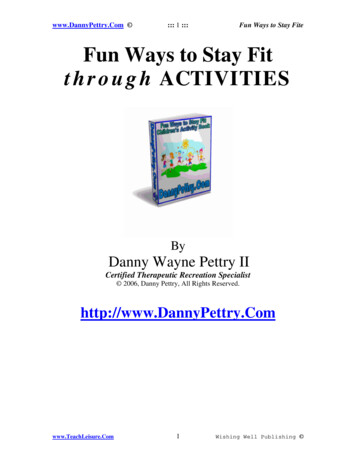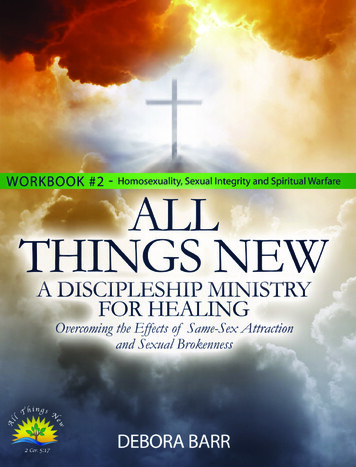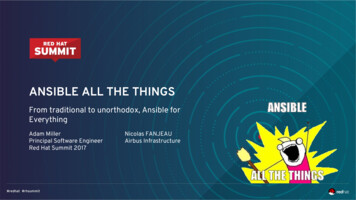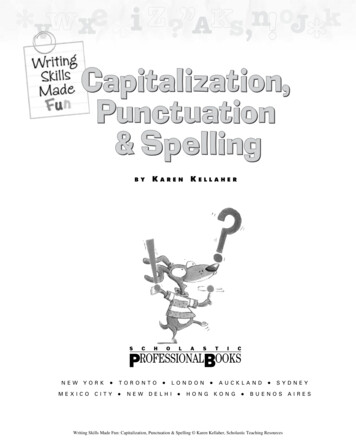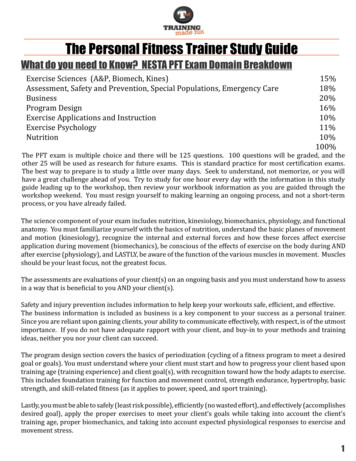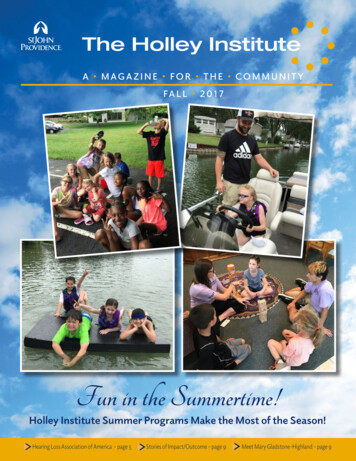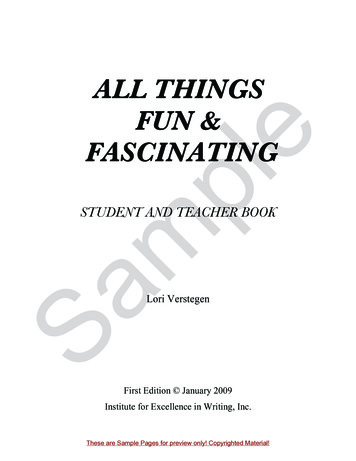
Transcription
pleALL THINGSFUN &FASCINATINGSamSTUDENT AND TEACHER BOOKLori VerstegenFirst Edition January 2009Institute for Excellence in Writing, Inc.These are Sample Pages for preview only! Copyrighted Material!
CONTENTSSCOPE & SEQUENCEiiiINTRODUCTION1Lesson 1eKEY WORD OUTLINES (IEW UNIT I) / ORAL REPORTSFUN FACTS FROM SCIENCEFloating Rocks3The Stinking Giant6Life PreserversA Giant LeapLimeysplLesson 28A Strange Creature111416mWRITING FROM KEY WORDS (IEW UNIT II)AESOP’S FABLESLesson 3Belling the Cat19Lesson 4The Crow and the Peacocks27Lesson 5The Ants and the Grasshoppers35SaNARRATIVE STORIES (IEW UNIT III)STORIES FROM AROUND THE WORLDLesson 6Damocles & the King (Three Parts)43Lesson 7Christian’s Burden Gone (from The Pilgrim’s Progress)53Lesson 8Pecos Bill (Three Parts)59Lesson 9Borrowing a Conflict71SPECIAL CHRISTMAS LESSON: POETRYA Cinquain75A Five-Senses Poem76An Acronym76iThese are Sample Pages for preview only! Copyrighted Material!
SUMMARIZING REFERENCES (IEW UNIT IV)AMAZING ANIMALSLesson 10Busy Beavers79Lesson 11A Bird with a Tasty Nest87Lesson 12Honeybees93Lesson 13Army Ants97Lesson 14Amazing Animal Homese103WRITING FROM PICTURES (IEW UNIT V)CARTOON CAPERSThe Kite RideLesson 16The Fishing Trip107plLesson 15113MULTIPLE SOURCE RESEARCH (IEW UNIT VI)MEN WHO CHANGED THE WORLDBenjamin FranklinmLesson 17117Lesson 18Louis Braille125Lesson 19Thomas Edison131Lesson 20Men Who Changed the World137SaCREATIVE WRITING (IEW UNIT VII)MY FAVORITE THINGSLesson 21My Favorite Activity141Lesson 22A Special Person145Lesson 23A Special Day150Final Review153FINAL REVIEWLesson 24APPENDIX: STYLE HELPSBanned Words and Prepositions155Substitutes for Banned Adjectives and Verbs156-ly Words160iiThese are Sample Pages for preview only! Copyrighted Material!
SCOPE AND SEQUENCELesson1StructureStyleIEW Unit I:Key Word OutlinesOral Reports23Strong VerbsIEW Unit II:Writing from OutlinesCreating Titles4Quality Adjectives-ly Words#3 Sentence OpenerDecoration: Alliteratione5SubjectEarth and Life ScienceAsteroids, Rafflesia, SeedsNeil Armstrong on the Moon,Vitamins, Sea HorseAesop’s Fables“Belling the Cat”“The Crowand the Peacocks”“The Ants andthe Grasshoppers”Stories from around the World“Damocles and the King”IEW Unit III:Narrative Stories7AllegoriesWho/Which ClauseThe Pilgrim’s Progress8Tall TalesSimile, Hyperbole#6 Sentence OpenerPecos Bill9Borrowing a Conflict1011121314IEW Unit IV:Topic Sentences andClinchers161718IEW Unit V:Writing from Pictures2122Swiftlet NestsHoneybee HivesArmy AntsAmazing Animal HomesDecoration: ConversationCartoon CapersThe Kite RideThe Because ClauseThe Fishing TripIEW Unit VI:Research Reports(one paragraph)Men Who Changed the WorldBenjamin FranklinLouis BrailleQuoting PeopleA Three-ParagraphResearch ReportIEW Unit VII:Creative WritingChristmasAmazing AnimalsBeaver LodgesThree-Paragraph Report1920Cinquain, Acronym,Five-Senses PoemDecoration: 3sssSa15Christmas PoetryAn Original Storymoptionalpl6Thomas EdisonMen Who Changed the WorldMy Favorite ThingsMy Favorite Activity#2 Sentence Opener23A Special PersonA Special DayiiiThese are Sample Pages for preview only! Copyrighted Material!
INTRODUCTIONGiant stinky flowers. Soup made from a bird’s nest. Men who changed theworld. These are just a few of the “fun and fascinating” things you will writeabout in the lessons of this book. More importantly, you will also learn howto write with structure and with style. You will write stories, reports, a mini-eresearch paper, poems, and creative essays. You will be surprised at howplmuch fun you will have writing!To the Parent or TeachermThe lessons in this book are designed to be taught weekly. On the first dayor two of the week, read through the lesson with your student(s). Writestudent ideas for key word outlines and for the brainstorming pages on awhiteboard. Students may write the ideas they like in their books, then haveSathe rest of the week to complete the assignment.Style HelpsThe appendix that begins on page 155 contains the style helps students willwant to refer to when they write. These include a list of the banned words, alist of some common prepositions, and lists of great adjectives, verbs, and-ly words to replace banned or boring words. Students should tab this sectionfor easy reference.1These are Sample Pages for preview only! Copyrighted Material!
ALL THINGS FUN & FASCINATINGTEACHER SUPPLEMENTAll the suggestions in this supplement are optional. They are here to help you teach andenrich the lessons in All Things Fun and Fascinating (AFF). There are six sections:Scheduling for the YearII.Tips for Teaching & Answers to Review Questionspage 5III.Review Gamespage 23V.plIV. Vocabulary Words*page 2eI.page 27Vocabulary Puzzles & Quizzespage 58mVI. Reward Ticketspage 34*The vocabulary words are highly recommended. They are great words chosen to fiteasily into many of the assignments, so students will have plenty of opportunity topractice using them. This is the best way to ensure that such vocabulary becomes part ofSathe natural writing vocabulary of a student. Puzzles, games, and quizzes are also providedto help students review the words. The words should be copied frompages 28–33 of this e-book and given to students during Lesson 2. Instructions forusing them are on page 27 and throughout the teacher tips.1These are Sample Pages for preview only! Copyrighted Material!
SCHEDULING FOR THE YEARThe lessons in All Things Fun & Fascinating (AFF) are designed to be taught weekly.Longer lessons are broken into sections so that students may complete them at their ownpace. Younger students may need an entire week for each section, whereas older studentsmay be able to do all the sections in a week.eIn a Home School or Daily ClassIf you are home schooling or otherwise meet every day, be flexible and work at a pacethat is comfortable for your child. You have the advantage of being able to break uppllessons into daily parts. Here is a suggested week’s schedule for Lessons in Units II–VI:Day 1:Outline togetherDay 2:Tell back info from outline; brainstorm elements of styleDay 3Review Day 2; write a rough draft, then have Mom/teacher proofreadmDays 4–5: Write a final draft. (Make corrections and add a picture.)In a Weekly Class SettingIf you are teaching a class that meets only weekly for instruction, the schedule on thefollowing pages will allow you time to proofread rough drafts before assigning finalSadrafts. I find that students learn much from correcting and polishing their first drafts. I donot grade rough drafts, but proofread them and use the proofreading marks on page 8 ofthis supplement to mark errors. You should copy this page for each student. It is good tohelp students develop a habit of writing, proofing, editing, and polishing their work.SHARING COMPOSITIONSIn a group, most students enjoy sharing their work. To make the most out of this time, asa student reads, write down good uses of the elements of style. Then, ask the classquestions about them, such as “What quality adjective did she use to describe?” If you are using the vocabulary words, as a students reads, have the classclap once quietly each time they hear one. These things will keep everyone payingattention.2These are Sample Pages for preview only! Copyrighted Material!
SCHEDULE FOR CLASSES THAT MEET ONCE A WEEKRD Rough Draft; FD Final DraftWeek LessonTeach lesson in class; assign writing for homeFloating Rocks1122A Giant Leap33Listen to Oral Reports assigned w/ Lesson 2Belling the Cat RD(Do not teach 3B yet)44The Crow and the Peacocks RD (Do not teach 4B yet)53B64B758510epl6ADamocles & the King, Sec. I RD6BDamocles & the King, Sec. II RD6CDamocles & the King, Sec. III RDSa11Proofreading Marks from Tips for Lesson 3BRead “Belling” rough drafts (see p. 2 above) / Discuss moralsAssign Belling the Cat FDRead “Crow & Peacocks” rough drafts/ Discuss moralsAssign The Crow and the Peacocks FDStudy for Vocab Quiz 1Ants & Grasshoppers RD(Save moral & alliteration for next week)Vocab Quiz 1Let students read rough drafts. Offer suggestions as necessary.Teach alliteration (AFF p. 41) / Discuss morals & titlesAssign Ants & Grasshoppers FDm9(Note: If Christmas break will fall on week 14, consider combiningLessons 1 & 2, letting students choose 4 of the 6 sources.)127136Christian’s Burden Gone RDStudy for Vocab Quiz 29 (opt)In class, share favorite elements of RD of DamoclesVocab Quiz 2Assign all three sections of Damocles & the King FDChristmas Poetry, AFF pp. 75–78Assign Christian’s Burden Gone FDRead Christmas poems or Christian’s Burden GonePlay a Vocabulary Review Game168, 8A(Lesson 9 homework optional over Christmas break)Pecos Bill, Sec. I RD178BPecos Bill, Sec. II RD188CPecos Bill, Sec. III, plus Assign Entire Story FD14157ChristmasPoetry3These are Sample Pages for preview only! Copyrighted Material!
1910Busy Beavers RD2011A Bird with a Tasty Nest RD2112Honeybees RD2213Army Ants FD (Ask parent to proofread RD)2314Amazing Animal Homes FD2415The Kite Ride RD2516The Fishing Trip RD261527162817Benjamin Franklin RD2918Louis Braille RDVocab Quiz 3eStudy for Vocab Quiz 4Vocab Quiz 4plIn class, begin group writing from pictures (Let kids draw pictures)At home, The Kite Ride FD*See note belowIn class, finish the group writing from picturesAt home, The Fishing Trip FDm30Study for Vocab Quiz 319Thomas Edison RD20Men Who Changed the World FD21My Favorite Activity22A Special Person3423A Special Day3524Review Games3132Sa33Study for Vocab Quiz 5Vocab Quiz 5Study for final quizFinal Vocabulary Quiz*Weeks 26–27: After discussing errors from the rough drafts of the stories written from thepictures in the book, assign the final drafts for homework. Then, in class, instruct students to drawa simple picture. Divide the class into groups of 2–4 students. Each group should choose one ofthe pictures to write about as a group. They will have both class periods to work on their story.Instruct them to tell what happened BEFORE the picture, DURING the picture, and AFTER thepicture. They should use the questions on page 108 of their AFF books for help. Encourage theuse of dress-ups and openers. Offer tickets for vocabulary words included. If a group finished toosoon, they can always add more elements of style. Remember a creative title. Save time at theend of class on week 27 to let the groups read their stories. These stories should not be graded.They are just for fun and practice; however, you could give tickets for outstanding elements.4These are Sample Pages for preview only! Copyrighted Material!
KEY WORD OUTLINES (IEW Unit I): Fun Facts from ScienceLESSON 1FLOATING ROCKSGoal: To practice key word outliningeKey word outlining will help you gather information to write about and willhelp you organize information in your compositions. Before you begin toThe Assignmentplwrite, you should practice key word outlining.1. Read “Floating Rocks” (page 4) all the way through. Thenreread it, one sentence at a time. On the blank outline on page 5,mwith the help of your teacher, write no more than three key wordsfrom each sentence. Choose words that will help you remember theidea of the sentence. You may use abbreviations and symbols.SaThese do not count as one of your three words. (See page 10.)2. Using only your key word outline, try to tell back the informationin your own words in complete sentences. Do this out loud foryour teacher or parent.3. Repeat this process with pages 6–9.Teacher note: You can have some fun helping students learn somecommon abbreviations and symbols if, one at a time, you write the symbolsfrom page 10 on the whiteboard and see if the students can guess what theymean.3These are Sample Pages for preview only! Copyrighted Material!
TIPS FOR TEACHING& ANSWERS TO REVIEW QUESTIONSLESSON 1 FLOATING ROCKSIn a class, outline together at least the first source text. Let students choose the three (orfewer) words for each sentence, then you write the words on the whiteboard. Encourageethe use of simple symbols and abbreviations. (See Teacher Note in AFF, page 3.) Eachstudent may then write their choice of words and abbreviations on their outline. Here is asample outline for “Floating Rocks” using symbols and abbreviations.plI. mil., rocks, floating, sol syst1. some, pulled, Earth2. burn, zoom, air3. look,stars4. most, grain, sandm5. few, lg, ground ! crater6. ! worry, only 1 killed7. dog, Egypt, 19118. atmosphere, good, protectingSaWhen the outline is finished, call on one student at a time to tell back the informationfrom one of the lines in a complete sentence.If there is class time left, allow students to outline the next source, “The Stinking Giant,”on their own. Students will complete the remaining outlines at home during the week.(Note: Lessons 1 & 2 may be combined by allowing students to choose four of the six source texts foroutlining. I do this if I need to in order to reach the Christmas lesson before Christmas break. Each yearthis depends on what day of the week I am teaching in relation to holidays like Labor Day andThanksgiving.)5These are Sample Pages for preview only! Copyrighted Material!
FLOATING ROCKSDid you know that there are millions of rocks floating in oursolar system? Some of these get pulled toward Earth. Then theyeburn brightly as they zoom through the air. They look like fallingstars. Most of the rocks are no larger than a grain of sand, so theyplburn up before they hit the earth. However, a few larger ones havereached the ground and left huge craters. But don’t worry—onlyone is known to have killed a living creature. It hit a dog in Egyptmin 1911. Our atmosphere does a wonderful job of protecting usSafrom falling rocks.4These are Sample Pages for preview only! Copyrighted Material!
OUTLINEI.1.e2.pl3.4.m5.6.Sa7.8.Remember, you may use symbols and abbreviations, and they do not countas words. Can you guess what the following symbols and abbreviationsmight mean? Create your own.sol. syst.(solar system) gr sand(smaller than a grain of sand)lg, hit ! craters(when large ones hit, they leave craters)5These are Sample Pages for preview only! Copyrighted Material!
THE STINKING GIANTThe rafflesia is the biggest flower in the world. Its bloom canbe three feet wide. It takes two years to form and stays open for aeweek. Unlike other flowers, it has no stem or leaves. It grows onthe roots of another plant. You do not want to get too close to thisplgiant flower, though, because its big blossom gives off a big stink!Some people say that it smells like rotting meat. Because of theawful smell, the rafflesia is also called a “corpse flower” or aSam“stinking lily.”6These are Sample Pages for preview only! Copyrighted Material!
OUTLINEI.e1.pl2.3.m4.5.Sa6.7.7These are Sample Pages for preview only! Copyrighted Material!
SUMMARIZING REFERENCES (IEW Unit IV): Amazing AnimalsLESSON 11A BIRD WITH A TASTY NESTeGoal: To continue to practice summarizing referencesReview1. What is the topic-clincher rule? (p. 80)The Assignmentpl2. How do you indicate the key words in the topic sentence andclincher that tell the topic of the paragraph? (p. 85)m1. Read the source text on page 88. Follow the same steps youfollowed in Lesson 10 to write one paragraph about swiftlets’nests. Be sure to have a clear topic sentence and clincher.Sa2. There is a Grammar Help on page 91.3. The checklist is on page 92.87These are Sample Pages for preview only! Copyrighted Material!
A BIRD WITH A TASTY NESTSwiftlets are birds that make nests tasty enough to eat! Theirnests are not made from sticks like other birds’ nests because swiftletsdo not live in trees. These birds live in caves in Asia. They craft theirenests from their saliva (spit). How?First, with its tongue, the male outlines the shape of the nest onthe cave wall. Next, the male and female work together. They expel apllayer of saliva over the outline. Their saliva is very thick and hardensquickly. Then they expel more saliva. They keep layering on the saliva.Soon the nest looks like half of a bowl stuck to the cave wall. Now themnest is ready. It looks and feels like dried white glue.One cave may have hundreds of swiftlets’ nests. Men go into thecaves to gather them. It is very dangerous, but they do it because thenests are very valuable. One pound of nests is worth almost 1000!SaWho buys the nests? Chefs buy them. They use them to makebird’s nest soup. This soup is considered a delicacy in Asia. One bowlof it contains only a few pieces of nest, but it can cost up to 100. Theswiftlet probably has not only the tastiest home, but also the mostexpensive home in the animal world!88These are Sample Pages for preview only! Copyrighted Material!
Note: If you outline on a separate sheet of paper, it will be easier to use theoutline with the brainstorming page and the checklist.KEY WORD OUTLINEeI. Topic Sentence: swiftlets’, nestspl1.2.m3.4.5.6.SaChooseat least5 facts,but nomorethan 7.7.Clincher:(Repeat or reflect 2–3 key words from your topic sentence.)89These are Sample Pages for preview only! Copyrighted Material!
Brainstorming Elements of StyleQuality AdjectivesFind nouns (people, animals, places, or things) in your paragraph. Think ofquality adjectives that could describe each. Here are two nouns:caves:What other nouns could you describe?enests:plmStrong Verbs & -ly WordsReplace these boring verbs with strong verbs. Add -ly words.Strong Verbs-ly WordsSwiftlets make their nests.SaMen get the nests.Your ideasDecoration Idea90These are Sample Pages for preview only! Copyrighted Material!
Grammar HelpPOSSESSIVE NOUNSFor singular nouns, add an ’s:The boy’s dog the dog that belongs to the boyFor plural nouns that end in s, just add the apostrophe:eThe boys’ dog the dog that belongs to more than one boyFor plural nouns that do not end in an s, add an ’s:Practice ExerciseplThe children’s dog the dog that belongs to the childrenmReview the Grammar Help on page 80 as well as the Grammar Help above.Circle the correct word in each of the parentheses.1. (Swiftlet’s, Swiftlets’) nests are made of spit.Sa2. (There, Their) saliva is thick and dries quickly.3. One (swiftlet’s, swiftlets’) eggs are safe in each nest.4. The male uses (its, it’s, its’) tongue to outline the nest.91These are Sample Pages for preview only! Copyrighted Material!
Lesson 11CHECKLIST“A Bird with a Tasty Nest”Structure(3 pts)Paragraph ends with a clincher(Words reflected from the topic sentence are highlighted)(3 pts)Title reflects words from clincher(5 pts)(Worth 2 pts each)plStyleeParagraph has a topic sentence (Key words highlighted)Dress-ups (Underline one of each and label in right margin)mStrong verb (v)-ly word (ly)Quality adjective (adj)Who/which clause (w/w)SaSentence Openers (Number each in left margin)#3 -ly word#6 vss (2–5 words)Decorations (One required. Label in right margin)Alliteration (allit) or Simile (sim)No banned words(-1 ea)TOTAL(Possible 25)92These are Sample Pages for preview only! Copyrighted Material!
CREATIVE WRITING (IEW Unit VII): My Favorite ThingsLESSON 21MY FAVORITE ACTIVITYGoal: To learn to ask questions to help you write from your own ideaseNotes from Your BrainplIn the final lessons of this book, you will be given prompts that tell you whatto write about, but you will not be given source texts or pictures. Where willyou get your ideas about what to write? From your brain! How will you getthe ideas out of your brain? By asking yourself questions.Here is the prompt for this lesson:Write about one of your favorite activities. An activity could be as simple asmplaying with a particular toy or as special as going on camping trips withyour family. What do you like to do?The AssignmentSa1. Before you begin writing, you must outline your ideas so that yourparagraph will be well organized. On page 143, write key wordnotes that will help you write a clear topic sentence. (This shouldbe the answer to the question in the prompt: What is one of yourfavorite activities?)2. Now you wi
FUN FACTS FROM SCIENCE Lesson 1 Floating Rocks 3 The Stinking Giant 6 Life Preservers 8 Lesson 2 A Giant Leap 11 Limeys 14 A Strange Creature 16 WRITING FROM KEY WORDS (IEW UNIT II) AESOP’S FABLES Lesson 3 Belling the Cat 19 Lesson 4 The Crow and
